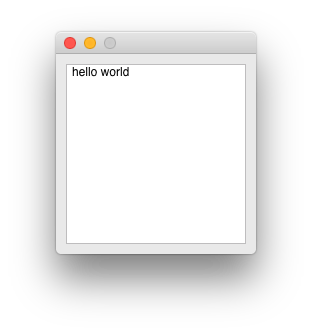TextEditor¶
-
class
vanilla.TextEditor(posSize, text='', callback=None, readOnly=False, checksSpelling=False)¶ Standard long text entry control.

from vanilla import Window, TextEditor class TextEditorDemo: def __init__(self): self.w = Window((200, 200)) self.w.textEditor = TextEditor((10, 10, -10, -10), text='hello world', callback=self.textEditorCallback) self.w.open() def textEditorCallback(self, sender): print("text entry!", sender.get()) TextEditorDemo()
posSize Tuple of form (left, top, width, height) or “auto” representing the position and size of the text entry control.
text The text to be displayed in the text entry control.
callback The method to be called when the user presses the text entry control.
readOnly Boolean representing if the text can be edited or not.
checksSpelling Boolean representing if spelling should be automatically checked or not.
-
addAutoPosSizeRules(rules, metrics=None)¶ Add auto layout rules for controls/view in this view.
rules must be a list of rule definitions. Rule definitions may take two forms:
- strings that follow the Visual Format Language
- dictionaries with the following key/value pairs:
key value “view1” The vanilla wrapped view for the left side of the rule. “attribute1” The attribute of the view for the left side of the rule. See below for options. “relation” (optional) The relationship between the left side of the rule and the right side of the rule. See below for options. The default value is “==”. “view2” The vanilla wrapped view for the right side of the rule. “attribute2” The attribute of the view for the right side of the rule. See below for options. “multiplier” (optional) The constant multiplied with the attribute on the right side of the rule as part of getting the modified attribute. The default value is 1. “constant” (optional) The constant added to the multiplied attribute value on the right side of the rule to yield the final modified attribute. The default value is 0. The attribute1 and attribute2 options are:
value AppKit equivalent “left” NSLayoutAttributeLeft “right” NSLayoutAttributeRight “top” NSLayoutAttributeTop “bottom” NSLayoutAttributeBottom “leading” NSLayoutAttributeLeading “trailing” NSLayoutAttributeTrailing “width” NSLayoutAttributeWidth “height” NSLayoutAttributeHeight “centerX” NSLayoutAttributeCenterX “centerY” NSLayoutAttributeCenterY “baseline” NSLayoutAttributeBaseline “lastBaseline” NSLayoutAttributeLastBaseline “firstBaseline” NSLayoutAttributeFirstBaseline Refer to the NSLayoutAttribute documentation for the information about what each of these do.
The relation options are:
value AppKit equivalent “<=” NSLayoutRelationLessThanOrEqual “==” NSLayoutRelationEqual “>=” NSLayoutRelationGreaterThanOrEqual Refer to the NSLayoutRelation documentation for the information about what each of these do.
metrics may be either None or a dict containing key value pairs representing metrics keywords used in the rules defined with strings.
-
enable(onOff)¶ Enable or disable the object. onOff should be a boolean.
-
get()¶ Get the contents of the text entry control.
-
getNSScrollView()¶ Return the NSScrollView that this object wraps.
-
getNSTextView()¶ Return the NSTextView that this object wraps.
-
getPosSize()¶ The position and size of the object as a tuple of form (left, top, width, height).
-
isVisible()¶ Return a bool indicating if the object is visible or not.
-
move(x, y)¶ Move the object by x units and y units.
-
resize(width, height)¶ Change the size of the object to width and height.
-
selectAll()¶ Select all text in the text entry control.
-
set(value)¶ Set the contents of the text box.
value A string representing the contents of the text box.
-
setPosSize(posSize, animate=False)¶ Set the position and size of the object.
posSize A tuple of form (left, top, width, height).
animate A boolean flag telling to animate the transition. Off by default.
-
show(onOff)¶ Show or hide the object.
onOff A boolean value representing if the object should be shown or not.
-